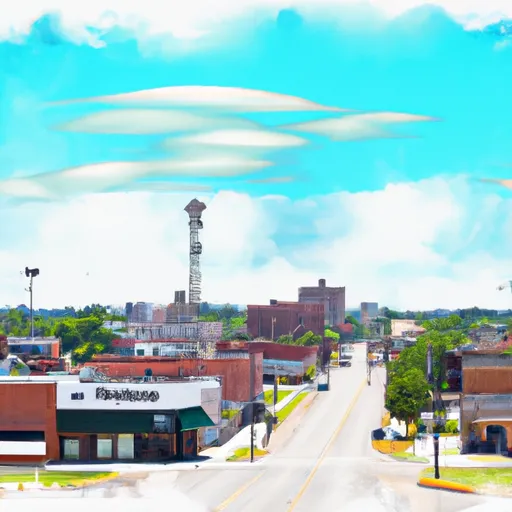-
 Snoflo Premium
Snoflo Premium
Get unlimited access to all our content
With no Ad interruptions! - Start Your Free Trial Login with existing account
Monroe
Eden Index
Climate
8.1
•
Recreation
2.5
•
Community
0.6
•
Safeguard
4.3/10

Monroe, Oklahoma, located in the southern part of the state, experiences a humid subtropical climate. Summers are hot and humid with temperatures reaching the high 90s°F (32-37°C), while winters are mild with temperatures averaging in the low 50s°F (10-15°C). Precipitation is evenly distributed throughout the year, with an annual average of around 40 inches (102 cm). Thunderstorms are common in the summer months.
The hydrology of Monroe is characterized by several lakes and rivers. The nearby Lake Monroe provides ample opportunities for water activities such as boating, fishing, and swimming. Additionally, the Little River, which runs through the city, offers a picturesque setting for water-based recreation.
Outdoor enthusiasts in Monroe can also enjoy various land-based activities. The city is surrounded by stunning natural areas, including state parks and wildlife management areas. Visitors can explore hiking trails, go camping, or engage in bird-watching and wildlife observation. The diverse and scenic landscapes of Monroe make it a perfect destination for outdoor enthusiasts seeking both water and land-based recreational opportunities.
What is the Eden Index?
The Snoflo Eden Index serves as a comprehensive rating system for regions, evaluating their desirability through a holistic assessment of climate health, outdoor recreation opportunities, and natural disaster risk, acknowledging the profound impact of these factors on livability and well-being.
Climate Health Indicator (CHI): 8.1
Monroe receives approximately
1227mm of rain per year,
with humidity levels near 85%
and air temperatures averaging around
17°C.
Monroe has a plant hardyness factor of
7, meaning
plants and agriculture in this region tend to thrive during the non-winter months.
By considering the ideal temperature range, reliable water supplies, clean air, and stable seasonal rain or snowpacks, the Climate Health Indicator (CHI) underscores the significance of a healthy climate as the foundation for quality living.
A healthy climate is paramount for ensuring a high quality of life and livability in a region, fostering both physical well-being and environmental harmony. This can be characterized by ideal temperatures, reliable access to water supplies, clean air, and consistent seasonal rain or snowpacks.
Weather Forecast
Streamflow Conditions
Robert S. Kerr Reservoir
Area Rivers
Robert S. Kerr Reservoir
Snowpack Depths
Robert S. Kerr Reservoir
Reservoir Storage Capacity
Robert S. Kerr Reservoir
Groundwater Levels
Recreational Opportunity Index (ROI): 2.5
The Recreational Opportunity Index (ROI) recognizes the value of outdoor recreational options, such as parks, hiking trails, camping sites, and fishing spots, while acknowledging that climate plays a pivotal role in ensuring the comfort and consistency of these experiences.
Access to outdoor recreational opportunities, encompassing activities such as parks, hiking, camping, and fishing, is crucial for overall well-being, and the climate plays a pivotal role in enabling and enhancing these experiences, ensuring that individuals can engage in nature-based activities comfortably and consistently.
Camping Areas
| Campground | Campsites | Reservations | Toilets | Showers | Elevation |
|---|---|---|---|---|---|
| Martin Creek Lake State Park | 93 | 347 ft | |||
| Jackson Creek Park - Lake Texarkana | None | 327 ft | |||
| Lake Of The Pines | 30 | 253 ft | |||
| Alley Creek - Lake Of The Pines | 65 | 262 ft | |||
| Johnson Creek - Lake Of The Pines | 95 | 280 ft | |||
| Cedar Springs - Lake Of The Pines | None | 269 ft | |||
| Buckhorn Creek - Lake Of The Pines | 60 | 283 ft | |||
| Daingerfield State Park | 52 | 402 ft | |||
| Brushy Creek - Lake Of The Pines | 60 | 290 ft | |||
| Hurricane Creek - Lake of the Pines | 23 | 226 ft |
Catastrophe Safeguard Index (CSI):
The Catastrophe Safeguard Index (CSI) recognizes that natural disaster risk, encompassing floods, fires, hurricanes, and tornadoes, can drastically affect safety and the overall appeal of an area.
The level of natural disaster risk in a region significantly affects safety and the overall livability, with climate change amplifying these risks by potentially increasing the frequency and intensity of events like floods, fires, hurricanes, and tornadoes, thereby posing substantial challenges to community resilience and well-being.
Community Resilience Indicator (CRI): 0.6
The Community Resilience Indicator (CRI) recognizes that education, healthcare, and socioeconomics are crucial to the well-being of a region. The CRI acknowledges the profound impact of these elements on residents' overall quality of life. By evaluating educational resources, healthcare accessibility, and economic inclusivity, the index captures the essential aspects that contribute to a thriving community, fostering resident satisfaction, equity, and social cohesion.

